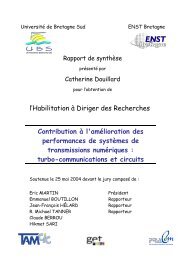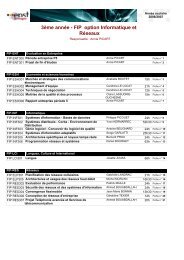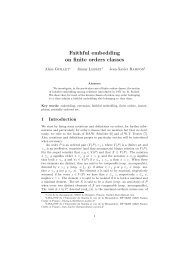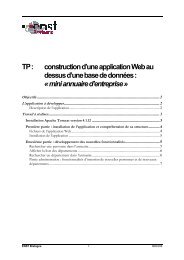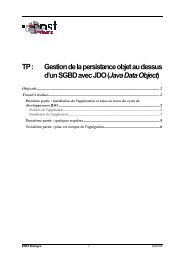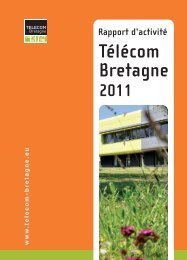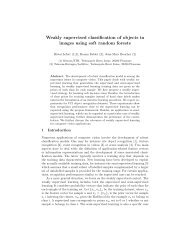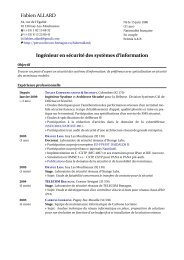researResearch - Télécom Bretagne
researResearch - Télécom Bretagne
researResearch - Télécom Bretagne
You also want an ePaper? Increase the reach of your titles
YUMPU automatically turns print PDFs into web optimized ePapers that Google loves.
esearc<br />
<strong>researResearch</strong><br />
52<br />
reduction. However, our first contribution shows<br />
that, the memory size for the state metrics can<br />
be reduced by 40% by a normalization of the state<br />
metrics without a significant loss of<br />
performance.<br />
Moreover, we have proposed an efficient way to<br />
reduce the dynamic power dissipation in the<br />
turbo decoder. This technique is based on a<br />
dynamic re-encoding of the received messages.<br />
The idea is to decrease the state transition<br />
activity of the trellis-based algorithms by<br />
replacing the classical direct decoding of the<br />
random noisy codewords by an equivalent<br />
decoding of an almost “all zero” codewords in<br />
order to keep the survivor path on the “zero<br />
path”.<br />
Simulation results showed that the state<br />
transition activity of the turbo decoding process<br />
is thus significantly reduced with no performance<br />
degradation. The design and the prototyping of a<br />
turbo decoder dedicated to the UMTS standard<br />
based on the proposed technique and a method<br />
to reduce the state metric quantization has been<br />
done. The objective was to measure the total<br />
power dissipation of the circuit.<br />
3. Algorithm-Architecture-<br />
Matching approach applied to a<br />
iterative receiver for MIMO system<br />
The information theoretical analysis of MIMO<br />
(Multiple Input Multiple Output) systems<br />
promises large capacity gains compared with<br />
conventional SISO (Single Input Single Output)<br />
system. A promising technique to achieve<br />
benefits such as higher data rate and improved<br />
link reliability is to utilize a full rate full diversity<br />
space-time (FR-FD ST) code. We will focus on<br />
one of them that deals with the association of<br />
linear precoding and spatial multiplexing. The<br />
presence of Forward Error Correcting (FEC) code<br />
in most of standardized systems allows the<br />
designer to take advantage of channel decoding<br />
by carrying out the turbo principle. In the context<br />
of transmission systems with interference, such<br />
an iterative receiver, known as turbo equalizer or<br />
turbo detector, achieves remarkable gains in<br />
BER performance, compared with a non iterative<br />
scheme. However, to design a high throughput,<br />
low complexity, and low latency architecture for<br />
an iterative receiver is a hard issue that slows<br />
down the technology transfer toward industry.<br />
We have proposed an architectural design of an<br />
iterative receiver for linearly precoded MIMO<br />
systems. The architectural exploration is driven<br />
by the limitation of the complexity and the FER<br />
performance. A new formulation of the MMSE<br />
algorithm has been considered to decrease the<br />
complexity of the SISO equalizer without error<br />
rate performance degradation. In order to reduce<br />
the memory required by the 64-state SISO<br />
decoder, the window sliding principle was<br />
applied. In addition, a particular block interleaver<br />
was proposed as an alternative to the random<br />
interleaver. However, the interleaving design rule<br />
imposes a latency which has an impact on the<br />
whole receiver. In order to obtain efficient<br />
exchange data process between the SISO<br />
equalizer and the SISO decoder, new interleaving<br />
design rules have to be investigated. The<br />
proposed architectural solution has been<br />
designed for a programmable target (FPGA) and<br />
implemented onto a prototyping board. The real<br />
time prototype demonstrate the performance of<br />
the proposed iterative receiver for MIMO<br />
systems.<br />
4. Designing a generic single-chip<br />
multiprocessor architecture for<br />
turbo-communication<br />
Applications in the field of digital<br />
communications are becoming more and more<br />
diversified and complex. This trend is driven by<br />
the emergence of turbo-communications which<br />
generalize the principle of iterative processing<br />
introduced by the turbo-codes. Implementation<br />
of turbo-communication systems, so-called<br />
turbo-receivers, is becoming crucial to reach the<br />
nowadays performance requirements in terms of<br />
transmission quality. Several dedicated<br />
implementations of these systems have already<br />
been proposed. However, implementation<br />
requirements in flexibility (to support the<br />
continuously developing new standards and<br />
applications in this field) and in high-throughput,<br />
make resorting to new design methodologies and<br />
the proposal of a flexible turbo communication<br />
platform inevitable.<br />
The subject of this project deals with the<br />
implementation of a generic multiprocessor<br />
platform dedicated to turbo-receivers et more



